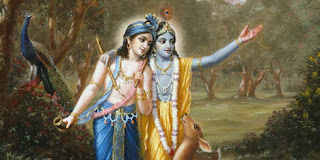 At first glance, the cosmology of the Srimad-Bhagavatam might seem like a wild fantasy. Here are four ways to make sense of it all.
At first glance, the cosmology of the Srimad-Bhagavatam might seem like a wild fantasy. Here are four ways to make sense of it all.The inquisitive human mind naturally yearns to understand the universe and man’s place within it. Today scientists rely on powerful telescopes and sophisticated computers to formulate cosmological theories. In former times, people got their information from traditional books of wisdom. Followers of the Vedic culture, for example, learned about the cosmos from scriptures like the Srimad-Bhagavatam, or Bhagavata Purana. But the Bhagavatam’s descriptions of the universe often baffle modern students of Vedic literature. Here Bhaktivedanta Institute scientist Sadaputa Dasa (Dr. Richard Thompson) suggests a framework for understanding the Bhagavatam’s descriptions that squares with our experience and modern discoveries.
This article was adapted from Mysteries of the Sacred Universe:
The Srimad-Bhagavatam presents an earth-centered conception of the cosmos. At first glance the cosmology seems foreign, but a closer look reveals that not only does the cosmology of the Bhagavatam describe the world of our experience, but it also presents a much larger and more complete cosmological picture. I’ll explain.
The Srimad-Bhagavatam’s mode of presentation is very different from the familiar modern approach. Although the Bhagavatam’s “Earth” (disk- shaped Bhu-mandala) may look unrealistic, careful study shows that the Bhagavatam uses Bhu-mandala to represent at least four reasonable and consistent models: (1) a polar- projection map of the Earth globe, (2) a map of the solar system, (3) a topographical map of south-central Asia, and (4) a map of the celestial realm of the demigods.
Chaitanya Mahaprabhu remarked, “In every verse of Srimad-Bhagavatam and in every syllable, there are various meanings.”(Chaitanya-charitamrita, Madhya 24.318) This appears to be true, in particular, of the cosmological section of the Bhagavatam, and it is interesting to see how we can bring out and clarify some of the meanings with reference to modern astronomy.
When one structure is used to represent several things in a composite map, there are bound to be contradictions. But these do not cause a problem if we understand the underlying intent. We can draw a parallel with medieval paintings portraying several parts of a story in one composition. For example, Masaccio’s painting “The Tribute Money” (Figure 1) shows Saint Peter in three parts of a Biblical story. We see him taking a coin from a fish, speaking to Jesus, and paying a tax collector. From a literal standpoint it is contradictory to have Saint Peter doing three things at once, yet each phase of the Biblical story makes sense in its own context.
A similar painting from India (Figure 2) shows three parts of a story about Krishna. Such paintings contain apparent contradictions, such as images of one character in different places, but a person who understands the story line will not be disturbed by this. The same is true of the Bhagavatam, which uses one model to represent different features of the cosmos.
The Bhagavatam Picture at First Glance
The Fifth Canto of the Srimad-Bhagavatam tells of innumerable universes. Each one is contained in a spherical shell surrounded by layers of elemental matter that mark the boundary between mundane space and the unlimited spiritual world.
The region within the shell (Figure 3) is called the Brahmanda, or “Brahma egg.” It contains an earth disk or plane—called Bhu-mandala—that divides it into an upper, heavenly half and a subterranean half, filled with water. Bhu-mandala is divided into a series of geographic features, traditionally called dvipas, or “islands,” varshas, or “regions,” and oceans.
In the center of Bhu-mandala (Figure 4) is the circular “island” of Jambudvipa, with nine varsha subdivisions. These include Bharata-varsha, which can be understood in one sense as India and in another as the total area inhabited by human beings. In the center of Jambudvipa stands the cone-shaped Sumeru Mountain, which represents the world axis and is surmounted by the city of Brahma, the universal creator.
To any modern, educated person, this sounds like science fiction. But is it? Let’s consider the four ways of seeing the Bhagavatam’s descriptions of the Bhu- mandala.
























